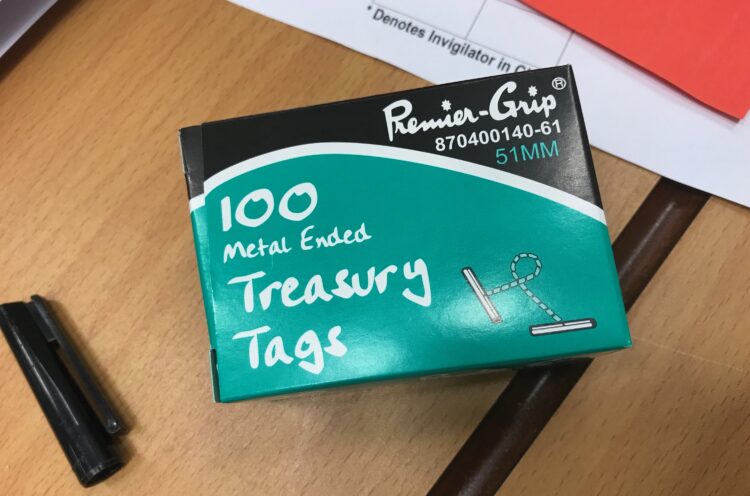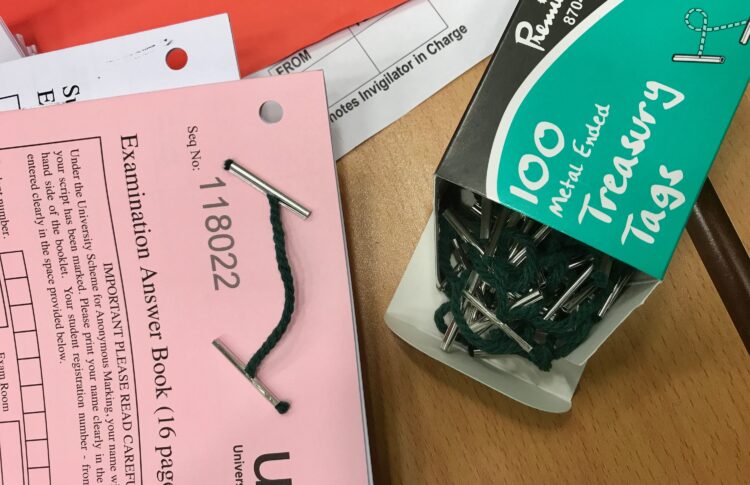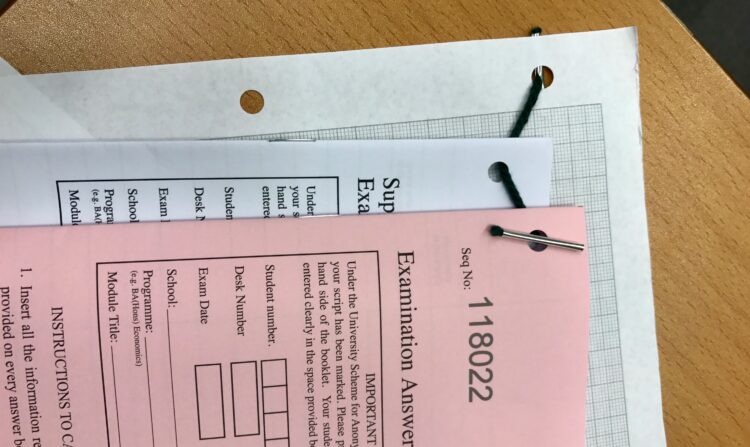
It’s May 4th, but if you want to see a Star Wars post at Bleistift today you’ll have to look at an old blog post.
Instead, today’s post will be about an item of stationery I’ve never seen before I came to the UK.
I’ve been working for a university for 16 years now, but even though I usually see this item when I go to the my department’s stationery cupboard I never really found much use for it, except during exam time.
I’m talking [1]actually: writing ;^P about the treasury tag.

Well, this morning me and my colleague were invigilating an exam for our first year students and the treasury tag came in very handy indeed. If you haven’t seen one: It’s a piece of string with mini metal (or plastic) bars/rods at the end. You use to to connect different hole punched documents – in this case exam answer books and graph paper or supplementary exam answer books.

I’d like to know whether treasury tags are used or known outside the UK. Please let me know whether these are known or maybe even commonly used in your country.

I also came across a few Staedtler Noris pencils from students and even some Noricas – they tend to be blue in the UK, unlike the American ones which tend to be black.

References
| ↑1 | actually: writing ;^P |
|---|
This is really intriguing. So it’s not rubber but just string, with metal stoppers at the ends? And the name is quirky too.
BTW I’ve finished with school long since but those desks in exam formation is enough for me to relive that sinking feeling…
Sola, thank you for your comment.
Yes, and they tend to be green, but other colours are available. There is also a version with one metal stopper/bar only and a looped string. You then fasten this by putting the string through the loop.
Well, I hope that sinking feeling was counteracted by seeing a new stationery item ;^)
I was going to say I’d never heard of treasury tags before, but then I saw the photos. I never knew they were called treasury tags! To be honest, I don’t think they’re used very often as people tend to prefer paper clips 🙂
Treasury tag is a beautiful name!
I like it. I may have seen the treasury tag used to fasten other items together. I did not know that was its original purpose. In the U.S. it was not uncommon to use round head brass paper fasteners with bendable prongs to group specific paper documents. These are still available at office supply stories. But, the paper staple and paper clip are the more common ways I have seen to group documents in the U.S. These do not need a punched hole.
Treasury tags! I love treasury tags and have never been able to find them outside of the UK. For a few years I worked in Brussels and by British boss kept stealing my supply as he couldn’t find any of his own.
If you have a big report, which is difficult for a stapler or a paperclip to handle, the treasury tag is a perfect tool. I would use them a great deal at work today if I were in the UK but am currently based in the US (which, generally speaking is wonderful for pens and pencils and stationery). I must find a source!
Thanks for the post
Available in the UK and Ireland! 🙂 Very handy little things. To solve the excess length you can loop the tag around the “spine” of the bundle and put it through the hole a second time. It holds the papers together more securely too. I’m not sure if that’s how they’re intended to be used but I’m definitely not the only person who does this… right… right? Ha!
Thank you very much for your comments and explanations.
Ben, I have seen these fasteners quite a lot in Germany, mainly to securely close padded envelopes. They are less common here in the UK.
Katharine, if you use them for big reports, do you hole punch the corner especially, or are your reports on hole punched paper anyway?
John, I kind of assumed the way you describe it is the proper way, but most people don’t do that because of laziness.. I’ll pay attention when I come across other people using them
I have a very vague memory of maybe having seen such a thing in my youth, but certainly very uncommon if they exist at all in the US.
The second type you mention, with one tab and a loop, do exist here – the loop is always elastic, though, never plain string.
Matthias – the answer is I’ve done both. I tend to find it’s easier to punch a hole in the corner in the sense that I find it easier to turn over the pages, but if the report has already been punched for a ring binder, I can use those holes. Mind you, the report tends to “flop around” more so I might still add a corner hole and use that instead.
Whether or not I double wrap the tag depends on the length. Some are very short indeed and you simply couldn’t do it. Others are inches, er, centimetres long and if you did not wrap at all then the papers would only be very loosely attached to each other and it would probably all get messy.
Treasury tags are very much a dowdy British item. The only time I’ve personally used them was for university exams, as described by Matthias in the main post.
They’re something that seems to invented, used, and spread by the British. I have a friend from southern India who says these are quite common over there too.
They were in pretty wide use in the pre-computer office, which is much before my time but I have seen them. I most notably came across them twice, during two separate temp jobs I had.
The first was for the local council in 2006. I was given an ancient archive box absolutely stuffed full of files from the ’70s and ’80s, each jammed full of foolscap-sized sheets, to photocopy onto A4. The intention was so that these new, single-sided A4 copies could be fed into a scanner for archiving whilst the originals were sent off for secure disposal.
Every multi-page document from the ’70s, and most from the early ’80s, had a punched hole in the corner through which a treasury tag was double looped to hold them together. The earliest of these sheets had council letterhead or “(CONTINUATION SHEET ___ OF ___)” printed at the top, and a diagonal line sectioning off the corner with the punch hole. The blank page numbers were either hand-written or typed in. The paper was ‘flimsy’ paper, known also as ‘onion skin’.
Initially, I would just fold back the pages to put the required page face out, but quickly grew irritated by the flopping mass of paper and started cutting through the treasury tags with a pocket knife. The pages held together with treasury tags were in better condition that the ones stapled or paper-clipped together, as most of those had rust spots on them.
One of the older ladies working there, just a couple of months from retiring at that point, had once been a typist for the council and she gave me more information about the files. File copies of documents were made using carbon paper onto ‘flimsy’, all of which was punched with a single hole at the top through which treasury tags were looped.
The second was working for an oil company. During a quiet spell, I was given the job of shredding ancient files from the mid-’90s or earlier. These documents were generally stapled together, but accompanying documents — copies of contracts, inspection reports, personnel files — were attached to the main document using treasury tags.
Thank you for your comments.
Nikki and Gunther, sorry I left you out in my previous comment.
Nikki, I guess staples address much more orderly if you file documents away, and they’re faster to apply. No wonder they won the race, but treasury tags gave their advantages, too.
Gunther, I agree. There’s another name, but less common. I think it is Indian tags or something similar.
Dan, are these looped ones common or quite rare in the US?
Katharine, thank you for this explanation. When they’re quite loose I usually dear they’ll fall apart, but with the length of that small bar that is actually quite unlikely.
Koralatov, that was a fascinating read. Thank you. If they make carbon paper copies to the flimsies they did that when writing the original – or is there another process, maybe similar to copying pencils, you meant? If not then why the flimsy paper, unless they had lots of copies to make in one go?
Hallo from Italy. I remember them from 25÷30 years ago or so. Maybe they felt in disgrace because of staplers?
What are you other suggestions for shortening them?
Do you make like John?
“To solve the excess length you can loop the tag around the “spine” of the bundle and put it through the hole a second time.”
Gianni, thank you for your comment. I assume when you saw these 25-30 years ago it was in Italy, is that right? Is so were they a niche product at the time – or were they somewhat common?
I think the way of shortening them, described in your comment, is the easiest way. The long bars mean you can’t shorten them using knots.
I was told that the carbon-copies — identifiable by their dark blue or dark purple ink — were made at the same time the originals were typed. She called it the “one-plus-two” rule: one original and two copies. Almost every document was created that way.
That would have entailed the bond paper, followed by a carbon sheet, followed by the first flimsy, followed by another carbon sheet, and then the final flimsy — quite a lot of paper even taking into account the thinness of the flimsy.
It seems this was an old habit which took a long time to die out. They had a gigantic photocopier first arrive some time in the ’80s, but for some years after that the “one-plus-two” routine was carried on. It only seemed to die out in the mid-’80s, going by what I was told and the noticeable increase in file thickness from that era onward. Photocopies were made onto regular copy paper, which had about twice the GSM of the flimsy it replaced.
I forgot to add that all this talk of treasury tags has shaken loose another recollection. Strange how things can get lost and then suddenly pop forth into the mind again years later.
There was, many years before my time, a stationer in Aberdeen which used to make treasury tags to order. My boss at a previous job, a stickler for correct stationery and the person who taught me the right way to use a paper-clip, told me about it — his wife had briefly worked there before they married in the late ’60s. You could order them to suit your particular requirements of colour, pattern, length, and even length of bar, although I’m told you had only two or three options for the length of the bar.
He told me that his former boss had been a collector of these local treasury tags. He’d died some years before this, and my boss had no idea what, if anything, had happened to this tag collection. I imagine his widow probably disposed of them not realising how unique they were.
Koralatov,
thank you for this explanation. This sounds like how many father did typewriter carbon copies when we wrote an invoice, etc. in his joinery. I think I just got confused because of the flimsy paper – he used normal paper, but normally only needed one copy.
When I first showed my wife the carbon copy paper (from Pelikan) she was fascinated, as she said the one she knows is not so dark and reusable. Vtechpower, from a youtube channel with stationery videos says carbon copy paper for typewriter can only be used once, but my father always used the normal one you can reuse. That makes me think whether the flimsy paper could not only be to accomodate more copies, it could also be special paper to work with special carbon copy paper. We used to have something ‘special’ here at the uni where I work. Assignment sheets had a second paper under it attached. You would get a copy, but there was no carbon copy in the middle. I assume the bottom of the top sheet and the top of the bottom sheet are both treated with a chemical which makes the carbon sheet unnecessary.
What a shame about the potentially lost treasury tag collection, but as always it was fascinating to read this and learn.
An interesting aside to the discussion of typewriters and carbon copies: When I learned to type, we were taught to always load two sheets, even if not making carbons, because the typewriters were _designed_ to strike hard enough for multiple copies and would dimple the roller if only one sheet were used.
I was an invigilator or invigilatrix 🙂 for 15 plus years here in the United States. My title was, “Testing Center Assistant”, but I was often referred to as a, “proctor”. I had never heard the term invigilator until I proctored a correspondence exam for a university in the UK. I was so fascinated with the treasury tags!!! I had never seen them before! I was also confused when the instructions for the exam said the student could take 2 Paracetamol and a bottle of water to with them to take the exam. I had to look up what that meant! I wish I would have picked up a box of treasury tags when I visited the UK, maybe next time! Cheers!
Thank you for your comments.
Dan, I never knew that. I guess for electric typewriters this makes sense. My manual typewriters’ rollers have ‘dents’ too, but I don’t press too hard – or maybe need a new ink ribbon so that I can press softer and still get a good ‘letter print’.
Paula, I didn’t know a proctor is the same as an invigilator. Not sure whether my students can take Paracetamol to the exam, but I don’t see why not.
We’ve got a rule here that didn’t exist in Germany, when I was still there: pencil cases have to be transparent.
Its used in the Civil Service in Ireland to keep the sacred files together. You will find decades old boxes in presses everywhere.
Pingback: Notarial String – pencil talk | pencil reviews and discussion
Hello, what a very nice item! I am from Germany and living in Spain and I never saw this in either of those countries. No I would love to have some!
This is interesting. I well remember typing onto two flimsies, probably in the 1970s. As for treasury tags, I was recently recommended to use them (again) by a fellow-photographer. When preparing to publish a book of photos, you could print out pairs of pages in black-and-white on A4 paper, so you could review the pairs of photos on opposite pages. You could print out the whole thing and join it loosely using treasury tags.
In a law office in the 70s I also remember using a ‘bodger’ (names vary). It had a metal point, a bit like a cross between a knife and a skewer, and you drove it through the corner of a bundle of documents to make a hole for the treasury tag to use.
Thank you for these details. I don’t think I’ve seen a bisher before. I had a quick look and found a description ( https://sainsburyarchive.org.uk/catalogue/search/sabl3161-bodger ) but no photo.
The description of how to use the treasury tags is great. Thank you.
Margaret, thank you for these details! This is exciting. Am I right in thinking that the device you have mentioned is also known as awl or pricker?
Matthias, I just remembered something. In Germany we have a binder called “Eckspanner” (corner file) which are closed by a rubber band. Today the rubber band is fixed to the cardboard (often with small rivets) but back then these rubber bands were very similar to treasury tags – they also had these metal stoppers which were threaded through the eyelet rivets.
That sounds right at Sainsburys. I see it was 1950s to 1970s. My blog post was 2003, the first year of my now almost decrepit blog. Some years ago I tried to get hold of one and found that bodger seemed not to be the usual name. What I got hold of I can’t remember where I got it. It has an eye for threading tape, I imagine. I have added a photo of it to my blog: http://transblawg.co.uk/2021/03/30/notarial-string-thread-or-yarn/
Thanks, Gunther – the pictures ‘awl’ brings up look just like what I remember.
Margaret, thank you for the additional details and the photo on you blog. Now I see – in Germany we call it “Ösenahle” (“eyelet awl”).
Thanks for Ösenahle, Gunther. I think that is what I have, but what we used in the office had no eye, so probably just Ahle. I think it was called a bodger because no one had a name for it!
Thank you for your comments.
Gunther, I have some Eckspanner folders here but don’t remember if I brought them from Germany or got them here in the UK. I didn’t know about the earlier version. Thank you.
Margaret, I thought of something like an awl, maybe because I see the one on my Swiss knife often and use it regularly, e.g. yesterday when making holes in a bird feeder …but something ‘unguided’ like that seems dangerous in an office where you can easily slip when punching holes – but I guess offices were more dangerous places in the past 🙂
I’m a British teacher in Australia and only found out the other day that treasury tags are completely underheard of here! My colleagues all had a good laugh at the ridiculous Britishness of them and couldn’t understand why I wouldn’t just use a paper clip ( a seriously inferior stationery item on my opinion). Long live the treasury tag!
I’ve just discovered the Treasury Tag via a British teacher who described how she uses them to secure photocopied pages in an A4 workbook on Tik Tok. I’m intrigued! I went searching online and have ordered a pack to trial with my Year 7 classes. Hopefully the tags will replace crusty, dried out glue sticks! I’m sure my students will be delighted at all the pages we save for note taking, rather than gluing sheets!
I hope you’ll like them!